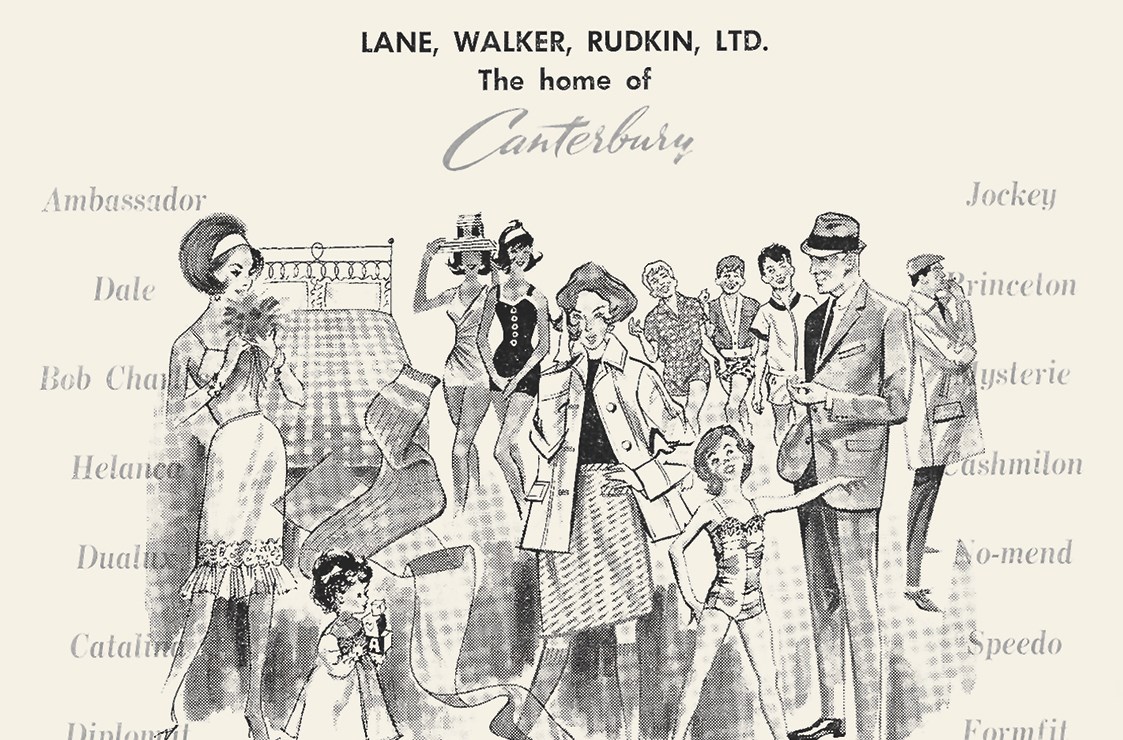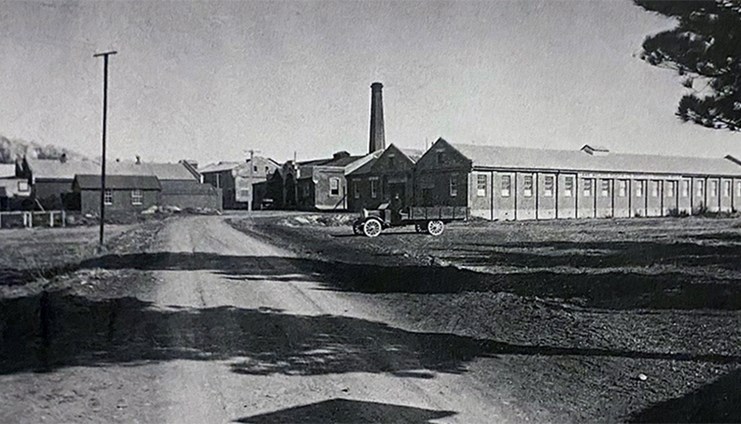Stories
Canterbury
1920s-

Although known for its iconic rugby jerseys, the first garment to be given the Canterbury label was underwear – the woollen kind worn in 1920s New Zealand.
Manufactured by Lane Walker & Rudkin (LWR), the newly branded Canterbury underwear was developed when Cecil Rudkin, son of the original founder, Sarah Rudkin and her husband Alfred, realised that the Christchurch factory’s major limitation was the seasonality of their woollen underwear and the resulting fall off in business for six months every year.
Sarah and Alfred immigrated to New Zealand in 1885 with their three young sons, Cecil, Lawrence and Ernest. Unfortunately Alfred was declared bankrupt in 1886 after a bad investment. To earn an income for her family, Sarah opened a shop in Christchurch but by 1893 she was knitting hosiery on a sock machine she had brought with her from England. She and Alfred started by knitting coarse work socks and black cardigans and slowly the business grew.

Sarah Rudkin. No Known Copyright Restrictions.
About 1902 Sarah signed a deal with the owners of an Ashburton woollen mill, John Lane and Pringle Walker. Alfred's bankruptcy charge meant he was unable to sign. In 1904 this partnership was formalised as Lane Walker Rudkin Ltd, combining two existing operations - yarn making and sock knitting.

The Lane Walker Rudkin factory in Ashburton. No Known Copyright Restrictions.
The business prospered, helped by the demand for khaki-coloured textiles during World War One. After the war, clothing shortages prompted the company to invest in new machinery and expand the factory.
Alfred Rudkin, and later his sons, regularly travelled to England to study the latest technology and purchase new knitting machines. They found ways to produce much finer woollen cloth using interlock knitting machines designed for cotton yarns. Bentleys, the English company that supplied many of LWR's machines, did not believe this was possible until one of their representatives saw it with their own eyes. The newly branded Canterbury underwear gained a reputation for being made of a finer, better fabric.
This was soon followed by the break-through the company needed to end the seasonality of their woollen underwear. In 1926, at Cecil’s instigation, the company bought a new locking machine, which was able to knit and stitch fine rayon because it used a stitch that prevented runs in the fabric. Developed from cellulose wood chips, rayon was one of the first man-made yarns, and the locknit machines using these yarns produced a fine, cool, light fabric ideal for lingerie and summer clothing.
Cecil ran the Christchurch operation of LWR for many years before being appointed chairman and managing director in the mid-1940s. Lawrence Rudkin remained a machine operator, mechanic and innovator throughout his career. Ernest came late into the business and he was responsible for developing the cotton rugby jersey that was to become the company’s own signature product. The cotton knit fabric introduced by Ernest was to supplant the heavy woollen jerseys worn at the time. Ernest also specialised in swimsuit fabrics, and the prestige that LWR enjoyed in the 1930s with the Pacific Swimwear by Canterbury brand was due mainly to his ability. One of his major triumphs was the production of the first elasticised woollen swimsuit fabric in New Zealand.
The Pacific brand was New Zealand's leading swimwear in the mid-twentieth century.
During World War II, LWR focused on essential items and army clothing. Dorothy Aldridge, whose association with LWR stretched over fifty years, joined in 1944 making ladies underwear. "We had to use buttons on the underwear rather than elastic because of war shortages. So if your underwear buttons popped off whilst you were walking through Cathedral Square, that was too bad – just part of the war sacrifices women made in those days."
After the austerity of the war years, the pent-up demand for clothing had to be met and LWR was able to focus on expanding production rather than marketing. By 1948, expanded manufacturing capacity from regional sites was contributing significant volumes to overall production. The company newsletter reported production of 520,000 bloomers and panties and 500,000 vests from the West Coast, 70,000 nightdresses from Blenheim, and further large quantities of outer and underwear from Christchurch’s three plants. Yet despite these quantities, the newsletter said Canterbury garments were still in short supply in the shops.

An ad promoting women's lingerie from September 1954. Image © Canterbury.
The Canterbury range of socks were mostly made from pre-dyed yarn from the Ashburton mill, requiring a huge range of colours to cover all the school and rugby club combinations around the country. Seamfree hosiery was also produced under the Canterbury label.
The tailoring department was set up after the war to add value to the worsted production from the Ashburton mill and, as representative of the peak of achievement in the apparel industry, there was considerable prestige in having tailoring in your department. Jackets and trousers were marketed under the Ambassador, Canterbury and Diplomat brands. Still in production in the late 1970s, the Canterbury suit was particularly successful in the middle price range.
From the 1980s, Canterbury International was to become LWR’s premium brand. The growing export of polycotton rugby jersey fabric from Christchurch to Canterbury International in Brisbane had become sufficient to justify a small plant in Brisbane. In 1988 a tiny building in was set up to house one electronic rugby striper, the trim knitting plant and two staff. Production initially was fabric for 1500 jerseys a week but around 1990 the rugby shirt and its more dressy counterpart, the light-weight polo shirt, suddenly took off, extending from rugby to golf, sailing, weekend-wear and womenswear. The plant extended to three shifts round the clock, and the first brand-new striper knitting machine was purchased.
The growing popularity of the Canterbury brand became closely aligned with world-class sporting events – a deliberate strategy by LWR. With rugby relationships already well formed, LWR turned to yachting to promote both the yachting pant and matching jerseys. Within three years, booming sales of sports apparel in New Zealand and overseas meant Canterbury had outgrown itself to become LWR's largest company employing more than 800 people. By 1985, the label had a new logo – the simple but effective three broad Cs – incorporating the silhouette of three kiwi heads. The sports apparel brand was so strong that the other companies in the LWR group were persuaded by executives to drop the Canterbury name on their products, so as not to dilute the brand in the marketplace.
Towards the end of the 1980s, a series of economic changes began to affect the fortunes of LWR. The 1987 stockmarket crash hit New Zealand hard and the country entered an economic recession. Government reforms reduced the import quotas and tariffs on apparel, dramatically affecting New Zealand's manufacturing industry. The resulting flood of imported garments provided stiff competition and many manufacturers struggled. LWR was forced to reduce its workforce and close a number of regional factories. Canterbury's retail stores were also facing reduced profits. However, the Canterbury brand remained in-house despite a series of ownership changes and restructures.
By the late 1990s, after eighty years' association with the All Blacks, the Canterbury brand had become closely tied to New Zealand's icon sports team. Canterbury was always willing to go the extra mile to ensure rugby was well looked after but when the six-year contract to supply the All Blacks expired in 1999, Canterbury lost out to German-based Adidas. Adidas was willing to pay more per annum for the rights to put their brand name on the black jerseys than LWR's capital value at the time. There was, understandably, a huge outcry, and the media speculated about the loss for days. But there was nothing Canterbury could do when faced with the millions that Adidas was offering.

Rugby great George Nepia wearing the LWR rugby jersey. Image © Canterbury.
In 2001, LWR industries including the manufacture of Canterbury gear was sold to Ken and Patricia Anderson. With experience in growing, spinning and making yarn, they could see at LWR an opportunity to control the process further. However, in 2009 the company was placed in receivership and closed after 104 years of operation.
Now owned by a British company, Pentland Group, Canterbury's New Zealand base is in Auckland. They continue to manufacture active leisurewear for an international market, exploring new design technologies to manufacture garments that optimise performance. Canterbury is worn by a number of sports teams including the Silver Ferns, the Warriors, Queensland State of Origin, the Black Caps and the domestic cricket and rugby teams. The English, Irish and South African international rugby teams also wear Canterbury.
Text by Felicity Price, author of Lane Walker Rudkin: 100 years in the making (Christchurch: Hazard Press, 2005). Banner image courtesy of Quentin Wilson.
Last published May 2014, updated November 2020.